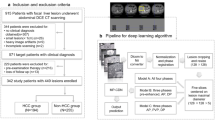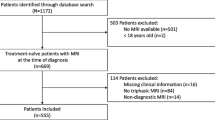Abstract
An interactive model for predicting the oncological outcome of patients with early-stage huge hepatocellular carcinoma (ES-HHCC) after hepatectomy is still lacking. This study was aimed at exploring the independent risk parameters and developing an interactive model for predicting the cancer-specific survival (CSS) of ES-HHCC. Data from patients with ES-HHCC who underwent hepatectomy were collected. The dimensionality of the clinical features was reduced by least absolute shrinkage and selection operator regression and further screened as predictors of CSS by Cox regression. Then, an interactive prediction model was developed and validated. Among the 514 screened patients, 311 and 203 of them were assigned into the training and validation cohort, respectively. Six independent variables, including alpha-fetoprotein, cirrhosis, microvascular invasion, satellite, tumor morphology, and tumor diameter, were identified and incorporated into the prediction model for CSS. The model achieved C-indices of 0.724 and 0.711 in the training and validation cohorts, respectively. Calibration curves showed general consistency in both cohorts. Compared with single predictor, the model had a better performance and greater benefit according to the time-independent receiver operating characteristic curve and decision curve analysis (P < 0.05). The calculator owned satisfactory accuracy and flexible operability for predicting the CSS of ES-HHCC, which could serve as a practical tool to stratify patients with different risks, and guide decision-making.





Similar content being viewed by others
Data availability
The data that support the study findings are available upon reasonable request from the corresponding author [Fubao Liu]. The full data are not publicly available due to limitations posed by the ethical regulations at some of the participating centers.
Abbreviations
- HCC:
-
Hepatocellular carcinoma
- ES-HHCC:
-
Early-stage huge hepatocellular carcinoma
- CSS:
-
Cancer-specific survival
- OS:
-
Overall survival
- IQR:
-
Interquartile rangel
- ROC:
-
Receiver operating characteristic
- DCA:
-
Decision curve analysis
- C-index:
-
Concordance index, AUC, Area under the curve
- CI:
-
Confidence interval
References
Sung H, Ferlay J, Siegel RL et al (2021) Global cancer statistics 2020: GLOBOCAN estimates of incidence and mortality worldwide for 36 cancers in 185 countries. CA Cancer J Clin 71(3):209–249. https://doi.org/10.3322/caac.21660
Heimbach JK, Kulik LM, Finn RS et al (2018) AASLD guidelines for the treatment of hepatocellular carcinoma. Hepatology 67(1):358–380. https://doi.org/10.1002/hep.29086
Xie DY, Ren ZG, Zhou J et al (2020) 2019 Chinese clinical guidelines for the management of hepatocellular carcinoma: updates and insights. Hepatobil Surg Nutr 9(4):452–463. https://doi.org/10.21037/hbsn-20-480
European Association for the Study of the Liver. Electronic address eee, European Association for the Study of the L (2018) EASL Clinical Practice Guidelines: Management of hepatocellular carcinoma. J Hepatol 69(1):182–236. https://doi.org/10.1016/j.jhep.2018.03.019
Reig M, Forner A, Rimola J et al (2022) BCLC strategy for prognosis prediction and treatment recommendation: the 2022 update. J Hepatol 76(3):681–693. https://doi.org/10.1016/j.jhep.2021.11.018
Zhou J, Sun H, Wang Z et al (2020) Guidelines for the diagnosis and treatment of hepatocellular carcinoma (2019 Edition). Liver Cancer 9(6):682–720. https://doi.org/10.1159/000509424
Tsoulfas G, Mekras A, Agorastou P et al (2012) Surgical treatment for large hepatocellular carcinoma: does size matter? ANZ J Surg 82(7–8):510–517. https://doi.org/10.1111/j.1445-2197.2012.06079.x
Wang JC, Hou JY, Chen JC et al (2021) Development and validation of prognostic nomograms for single large and huge hepatocellular carcinoma after curative resection. Eur J Cancer 155:85–96. https://doi.org/10.1016/j.ejca.2021.07.009
Chen Z, Cai M, Wang X et al (2021) Two novel online nomograms for predicting the survival of individual patients undergoing partial hepatectomy for huge hepatocellular carcinoma. HPB (Oxford) 23(8):1217–1229. https://doi.org/10.1016/j.hpb.2020.12.002
Peterson JC, Bourgin DD, Agrawal M et al (2021) Using large-scale experiments and machine learning to discover theories of human decision-making. Science 372(6547):1209–1214. https://doi.org/10.1126/science.abe2629
Tibshirani R (2011) Regression shrinkage and selection via the lasso: a retrospective. J R Stat Soc Ser B Stat Methodol 73(3):273–282. https://doi.org/10.1111/j.1467-9868.2011.00771.x
Qian NS, Liao YH, Cai SW et al (2013) Comprehensive application of modern technologies in precise liver resection. Hepatobil Pancreat Dis Int 12(3):244–250. https://doi.org/10.1016/s1499-3872(13)60040-5
Wakabayashi G, Cherqui D, Geller DA et al (2022) The Tokyo 2020 terminology of liver anatomy and resections: updates of the Brisbane 2000 system. J Hepatobiliary Pancreat Sci 29(1):6–15. https://doi.org/10.1002/jhbp.1091
Gonvers S, Jurt J, Joliat GR et al (2021) Biological impact of an enhanced recovery after surgery programme in liver surgery. BJS Open. https://doi.org/10.1093/bjsopen/zraa015
Kidd AC, McGettrick M, Tsim S et al (2018) Survival prediction in mesothelioma using a scalable Lasso regression model: instructions for use and initial performance using clinical predictors. BMJ Open Respir Res 5(1):e000240. https://doi.org/10.1136/bmjresp-2017-000240
Bruix J, Fuster J (2015) A snapshot of the effective indications and results of surgery for hepatocellular carcinoma in tertiary referral centers: is it adherent to the EASL/AASLD recommendations? An observational study of the HCC East-West Study Group. Ann Surg 262(1):e30. https://doi.org/10.1097/sla.0000000000000381
Mazzaferro V, Regalia E, Doci R et al (1996) Liver transplantation for the treatment of small hepatocellular carcinomas in patients with cirrhosis. N Engl J Med 334(11):693–699. https://doi.org/10.1056/nejm199603143341104
Llovet JM, Brú C, Bruix J (1999) Prognosis of hepatocellular carcinoma: the BCLC staging classification. Semin Liver Dis 19(3):329–338. https://doi.org/10.1055/s-2007-1007122
Fang Q, Xie Q-S, Chen J-M et al (2019) Long-term outcomes after hepatectomy of huge hepatocellular carcinoma: A single-center experience in China. Hepatobiliary Pancreat Dis Int 18(6):532–537. https://doi.org/10.1016/j.hbpd.2019.09.001
Li C, Wang H, Chen R et al (2022) Outcomes and recurrence patterns following curative hepatectomy for hepatocellular carcinoma patients with different China liver cancer staging. Am J Cancer Res 12(2):907–921
Yang LY, Fang F, Ou DP et al (2009) Solitary large hepatocellular carcinoma: a specific subtype of hepatocellular carcinoma with good outcome after hepatic resection. Ann Surg 249(1):118–123. https://doi.org/10.1097/SLA.0b013e3181904988
Yang L, Xu J, Ou D et al (2013) Hepatectomy for huge hepatocellular carcinoma: single institute’s experience. World J Surg 37(9):2189–2196. https://doi.org/10.1007/s00268-013-2095-5
Sun J, Guo R, Bi X et al (2022) Guidelines for diagnosis and treatment of hepatocellular carcinoma with portal vein tumor thrombus in China (2021 Edition). Liver Cancer 11(4):315–328. https://doi.org/10.1159/000523997
Wang XH, Liu QB, Xiang CL et al (2021) Multi-institutional validation of novel models for predicting the prognosis of patients with huge hepatocellular carcinoma. Int J Cancer 149(1):127–138. https://doi.org/10.1002/ijc.33516
Fang KC, Kao WY, Su CW et al (2018) The prognosis of single large hepatocellular carcinoma was distinct from barcelona clinic liver cancer stage A or B: the role of albumin-bilirubin grade. Liver Cancer 7(4):335–358. https://doi.org/10.1159/000487407
Xu XF, Wu H, Li JD et al (2023) Association of tumor morphology with long-term prognosis after liver resection for patients with a solitary huge hepatocellular carcinoma—a multicenter propensity score matching analysis. Hepatobiliary Surg Nutr 12(3):314–327. https://doi.org/10.21037/hbsn-21-423
Patzer RE, Kaji AH, Fong Y (2021) TRIPOD reporting guidelines for diagnostic and prognostic studies. JAMA Surg 156(7):675–676. https://doi.org/10.1001/jamasurg.2021.0537
Balachandran VP, Gonen M, Smith JJ et al (2015) Nomograms in oncology: more than meets the eye. Lancet Oncol 16(4):e173–e180. https://doi.org/10.1016/s1470-2045(14)71116-7
Shi JY, Wang X, Ding GY et al (2021) Exploring prognostic indicators in the pathological images of hepatocellular carcinoma based on deep learning. Gut 70(5):951–961. https://doi.org/10.1136/gutjnl-2020-320930
Bera K, Braman N, Gupta A et al (2021) Predicting cancer outcomes with radiomics and artificial intelligence in radiology. Nat Rev Clin Oncol 19(2):132–146. https://doi.org/10.1038/s41571-021-00560-7
Acknowledgements
We would like to thank Prof. Faming Pan (Department of Epidemiology and Biostatistics, School of Public Health, Anhui Medical University) for his full access to all the data in the present study and his responsibility for the integrity and accuracy of the data analysis.
Funding
This study was supported by the University Natural Science Research Project of Anhui Province (No. KJ2021ZD0021) & the Postgraduate Innovation Research and Practice Program of Anhui Medical University (YJS20230024). The funding sources had no role in the design and conduct of the study; collection, management, analysis, and interpretation of the data; preparation, review, or approval of the manuscript; and decision to submit the manuscript for publication.
Author information
Authors and Affiliations
Contributions
FL, XG, ZC. Study design: FL, ZC, JC. Data acquisition: ZC, PM, HS, HH, JM, KH. Quality control of data and algorithms: FL, ZC. Data analysis and interpretation: PM, PM. Statistical analysis: ZC, PM. Manuscript preparation: ZC, FL. Manuscript editing: FL, XG, JC. Manuscript review: FL. Final approval of manuscript: All authors. ZC, HS, PM contributed equally to this work and were considered as co-first authors.
Corresponding author
Ethics declarations
Conflict of interest
The authors declare no conflict of interest.
Ethical statement
The study procedures were approved by the institutional ethics committee of the First Affiliated Hospital of Anhui Medical University (No. P-2021-1230).
Additional information
Publisher's Note
Springer Nature remains neutral with regard to jurisdictional claims in published maps and institutional affiliations.
Supplementary Information
Below is the link to the electronic supplementary material.
13304_2024_1766_MOESM2_ESM.tif
Supplementary Figure 2 ROC curves of the interactive model for predicting the 1-, 3-, and 5-year CSS of ES-HHCC patients after hepatectomy in the training (A) and validation (B) cohort. ROC, receiver operating characteristic curve. CSS, cancer-specific survival. ES-HHCC, early-stage huge hepatocellular carcinoma.
13304_2024_1766_MOESM3_ESM.tif
Supplementary Figure 3 Time-independent ROC curves of the interactive model for predicting the CSS of ES-HHCC patients after hepatectomy in the training (A) and validation (B) cohort. ROC, receiver operating characteristic curve. CSS, cancer-specific survival. ES-HHCC, early-stage huge hepatocellular carcinoma
13304_2024_1766_MOESM4_ESM.tif
Supplementary Figure 4 DCA of the interactive model for predicting the CSS of ES-HHCC patients after hepatectomy in the training (A) and validation cohort (B). DCA, decision curve analysis. CSS, cancer-specific survival. ES-HHCC, early-stage huge hepatocellular carcinoma
13304_2024_1766_MOESM5_ESM.tif
Supplementary Figure 5 Kaplan–Meier survival curves for risk subgroups of patients estimating the OS of ES-HHCC patients after hepatectomy in the training cohort. OS, overall survival. ES-HHCC, early-stage huge hepatocellular carcinoma
Rights and permissions
Springer Nature or its licensor (e.g. a society or other partner) holds exclusive rights to this article under a publishing agreement with the author(s) or other rightsholder(s); author self-archiving of the accepted manuscript version of this article is solely governed by the terms of such publishing agreement and applicable law.
About this article
Cite this article
Chen, Z., Sun, H., Ma, P. et al. Interactive model for predicting the oncological outcome of patients with early-stage huge hepatocellular carcinoma after hepatectomy: a multicenter population-based study. Updates Surg 76, 447–458 (2024). https://doi.org/10.1007/s13304-024-01766-x
Received:
Accepted:
Published:
Issue Date:
DOI: https://doi.org/10.1007/s13304-024-01766-x




